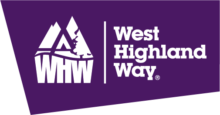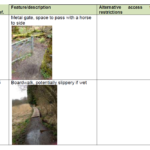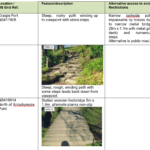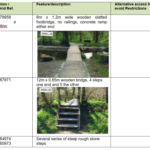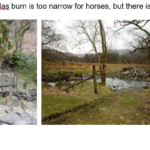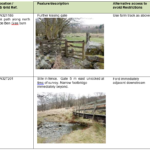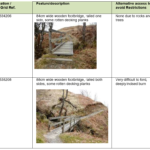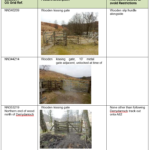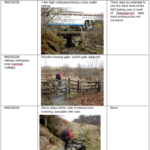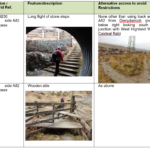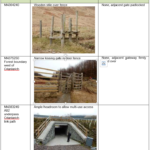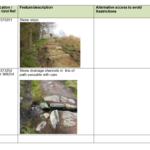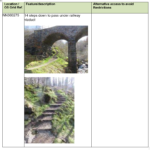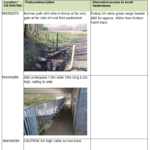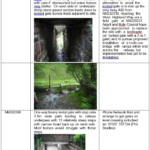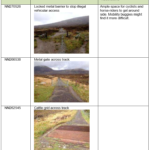West Highland Way – multi-use access
The route was originally designed and created as a walking route. Since then access legislation in Scotland has changed. Cyclists and horse riders now enjoy equal access rights to walkers, provided they exercise those rights responsibly. Notwithstanding this, some sections of the West Highland Way, such as the narrow path around the north-east corner of Loch Lomond, are impassable with a horse and never likely to be suitable for multi-use. Other parts are accessible with a horse or bike.
These notes have been produced by British Horse Society Scotland to help those interested in using part or all of the West Highland Way to identify location and brief details of features which may restrict multi-use of the waymarked route. Only those which may present an issue for experienced riders are noted below – shallow fords, vehicular bridges, cross drains, gates off their hinges or which can only be opened or closed if dismounted, rough ground, sheep and cattle are all part of riding off-road and so are not documented. Inclusion of a particular feature does not necessarily mean that it is impassable with a horse. Photos have been included where appropriate to help you assess for yourself whether a feature such as steps, a narrow footbridge, gate or gap less than 1.5m wide may present an obstruction to you. These notes are intended to supplement detailed route guides and other information already available from the West Highland Way website.
Suggestions for parking and alternative routes to avoid restrictions on multi-use are included where information has been provided by volunteers, but do not constitute a recommendation. All route users are responsible for deciding for themselves whether this route, or any part of it, is suitable for their intended use, taking account of their own abilities, skills, fitness and experience, as well as season, weather conditions etc. Event organisers, groups or commercial operators considering using the West Highland Way are urged to contact the route managers
Remember that whether on foot, cycle or horseback, rights of access in Scotland depend on access takers and land managers accepting individual responsibility for their actions. The Scottish Outdoor Access Code defines what this means on the ground. Specific guidance for horse riders can be found on the BHS website.
Courtesy, consideration of others’ needs and good communication are the key to sharing paths. Always pass others you meet along the trail at a walk, and elsewhere limit your pace to ground conditions and visibility. On surfaced paths and other well used sections of the route, riders need to be particularly careful to respect other users and clear dung off the path. The route should be waymarked throughout, but in some places waymarks are not readily apparent, so make sure you have a map with you and know how to read it.
All of this section is multi-use accessible other than the off-road route over Conic Hill. The path up the east side of Conic Hill is narrow, steep and rocky with numerous steps, and there is a kissing gate at OSGR NS424914. The alternative is to follow the track south from Garadh BanWood past Creityhall to Milton of Buchanan and then the B837 to Balmaha. Horsebox parking is signed off the road in Garadhban Forest at OSGR NS479906.
The off-road sections of West Highland Way between Balmaha and Rowardennan are mainly narrow and eroded in places, which together with numerous steps and exposed tree roots make most of this section unsuitable for off-road equestrian use. The public road which coincides with the West Highland Way in some parts and runs roughly parallel for the remainder offers a multi-use alternative but is narrow, twisting and very busy in summer and at weekends. Parking is restricted to public car parks at Balmaha and Rowardennan.
The route follows a forest road through this section (the original lochside route is in poor condition and rarely used). The forest road is largely accessible to all incl. horseriders. The forest road rejoins the original route at Rowchoish, passes Cailness and eventually into Inversnaid. A footbridge and section of path just north of Inversnaid was replaced in 2023 – making this short section accessible to all.
Impassable with a horse
This section of the West Highland Way is well-known for being the most taxing even for walkers. Although some parts of it might in theory be multi-use accessible, numerous natural and man-made features make it impassable with a horse and very difficult with a bike. The path takes the line of least resistance, often following a narrow strip between crags and loch, with a precipitous slope on either side, in some places restricted by large boulders which would be difficult if not impossible to pass with a horse, in others across boggy ground. Stepping stones over burns have been sited at the easiest crossing, which all too often does not coincide or easily link with somewhere horses might more easily ford or jump across the burn. In various places where steps have been constructed up steep slopes, there is no alternative way round, nor space to pass alongside. Narrow footbridges with steps either end, kissing gates, stiles and open slatted boardwalks present further restrictions and obstructions, albeit academic given the nature of the remainder of this section. In view of the number of restrictions and impassability with a horse, and the lack of link or loop paths to enable use of smaller parts of this section, individual obstructions have not been individually listed.
Impassable with a horse due to stiles and kissing gates, even on sections of track otherwise suitable for multi-use.
An unavoidable kissing gate in deer fence at the forest boundary just west of Crianlarich obstructs multi-use on the section of West Highland Way through to the A82, but all other gates, bridges, underpasses and steps between Crianlarich and Tyndrum are either passable with care or there is a viable alternative. There is usually space to park trailers and horseboxes in the main public car park at Crianlarich, and potentially in the trailer/HGV area at the Green Welly café in Tyndrum.
For much of its length, this section of the West Highland Way follows a broad, firm, hard surfaced track which is ideal for multi-use, although the section east of the railway line is along a much narrower stony path. The two major restrictions on multi-use are the railway underpass and locked level crossing at Bridge of Orchy, and a very narrow underpass and locked gate just north of the regional boundary (see below). Horse riders concerned about trains on the railway line which runs parallel and in some places very close to the track (30m max. separation) are advised to check timetables in advance.
No obstructions or restrictions, bridlegate alongside main locked gate.
This section of route is passable with a sure-footed horse but includes various narrow footbridges, rocky outcrops, fords and sections of steep rocky path which some inexperienced horse-riders may find challenging, particularly during or after wet weather.
